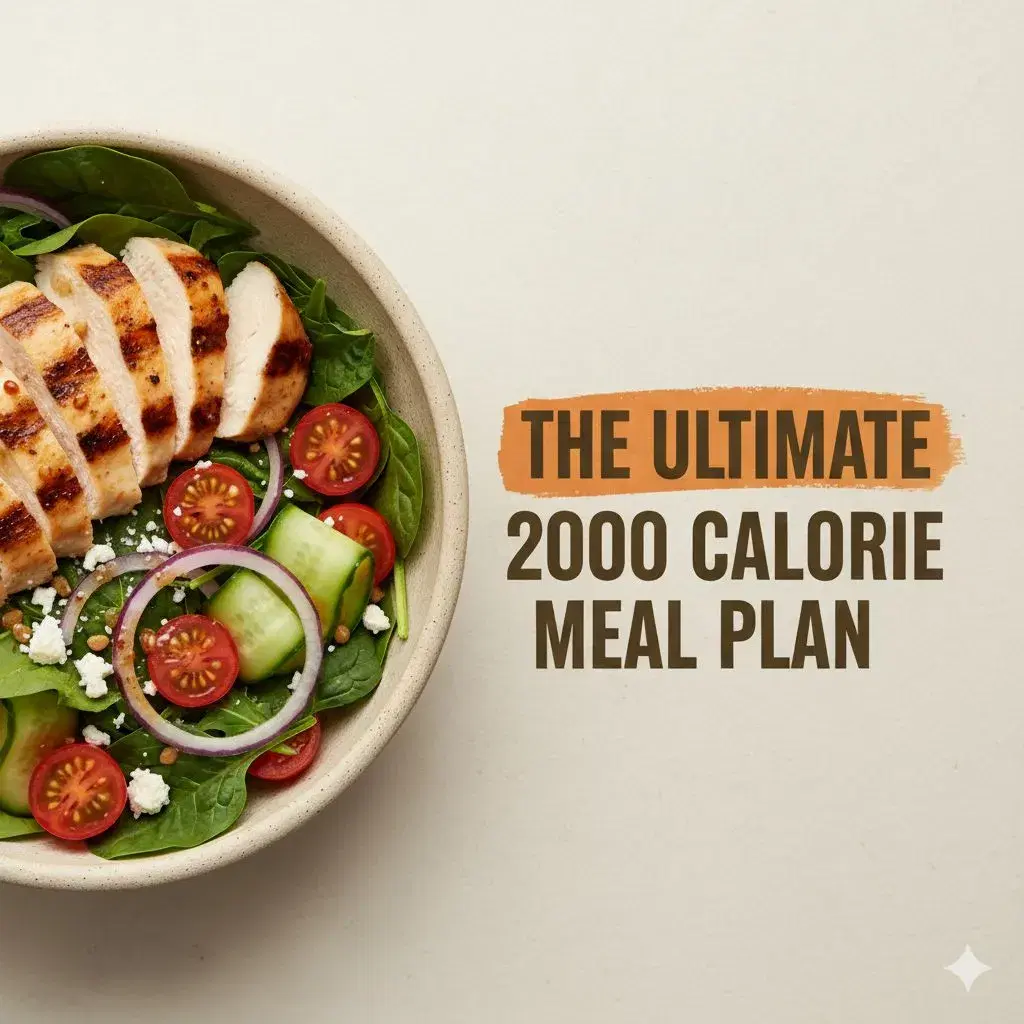2000 Calorie Meal Plan

Think of calories like your daily budget you’ve only got so much to spend, and how you spend it matters. A 2000 calorie meal plan gives many adults enough energy for daily life without overspending or running on empty. But it’s not a one-size-fits-all number. It’s a guidepost. Your ideal pace depends on your body, your routine, and your goals.
Here in the UAE, the numbers tell their own story. Nearly 74% of adults are overweight, and about 37% fall into the obese category as per Frontiers. In Dubai, the picture is even sharper, over 1 in 5 women and almost 40% of Emirati nationals fall into the obese range based on the data by PMC, U.S. National Institutes of Health’s National Library of Medicine.
It’s a clear reminder that what we eat isn’t just about personal choice, it’s become a public health concern.
And that’s where this guide comes in. It’s built for busy professionals short on time, newcomers still figuring out the food scene, gym-goers stuck in a plateau, and anyone who simply wants to eat smart without going rigid.
We’ll walk you through a clear path: the problem → your goals → the real-life obstacles → and finally, the solution that makes it all practical.
Who actually benefits from a 2000 calorie diet plan?
Let’s clear the air: this plan isn’t about squeezing into a one-size-fits-all mold. It’s more of a reliable framework.
This plan works best if you’re:
- Keeping your weight steady without counting every calorie.
- Active in a simple way, gym a few times, regular walks, or on your feet at work.
- Choosing balance over crash diets or complicated tracking.
Here’s a reality check though: As per the ministry of health & prevention in the UAE, around 3 in 10 adults live with obesity, and it’s often tied to a mix of poor diet, low activity, and the rising risk of type 2 diabetes.
So, who really needs to adjust? If you’re an athlete pushing through tough training, a teenager still growing, or a mum-to-be, your body’s going to ask for extra fuel. On the other hand, if you’re smaller in build or spend most of your day sitting, especially if weight loss is the goal, you’ll likely need less.
The point is simple: your diet should line up with your goals. That’s also why a 2000 calorie diet plan isn’t a standalone fix. Food and movement have to work hand in hand.
Here’s the balance:
- Eat a little less if fat loss is your target.
- Eat a little more if you’re building muscle.
- Keep it steady if you’re maintaining.
And wherever you are on that spectrum, don’t skip the exercise, it’s what turns the numbers on your plate into progress you can actually feel.
How to split macros on a 2,000-calorie eating plan?
As suggested, if your 2,000 calories is like a budget, you don’t want to blow it all in one place. Here’s the simple breakdown:
- Protein (about 20–25% | 100–125g): Builds muscle and keeps you full. Easy sources? Chicken, eggs, fish, beans, Greek yogurt.
- Carbs (around 40–50% | 225–250g): Your body’s fuel. Whole grains, fruit, potatoes, the stuff that actually gives you energy, not just sugar crashes.
- Fats (about 25–30% | 55–65g): Keeps your hormones and brain happy. Avocado, nuts, olive oil, giving quality over quantity.
How to split it through the day:
- Breakfast: 400- 500 calories
- Lunch: 500- 600 calories
- Dinner: 500-600 calories
- Snacks: 300- 400 calories
Think of it like building a playlist: protein’s the main act, carbs keep the beat, and fats tie it all together.
A 7-day 2000 calorie meal plan that actually tastes good
Eating healthy doesn’t mean every meal has to taste the same or feel like a chore. And no, the calories don’t need to be split evenly at every sitting either. Some days you might start light and end heavier, other days it’s the opposite. As long as the full day adds up to roughly 2,000 calories, you’re right on track. Here’s a balanced 2000 calorie meal plan from Delicut that switches things up so your plate and your palate never get bored.
Day 1
• Breakfast (500): Veggie omelet with spinach and mushrooms, roasted sweet potato, and whole-grain toast.
• Snack (200): Berry smoothie.
• Lunch (500): BBQ chicken with quinoa & green beans
• Snack (200): Cheese & nuts Pot
• Dinner (600): Lemon & dill salmon with roasted veggies
Day 2
• Breakfast (500): Oats porridge with berry glaze
• Snack (250): Low cal raspberry pannacotta
• Lunch (480): Wholegrain tunacado sandwich.
• Snack (180): Crudites with sour cream dip
• Dinner (600): Chicken stir-fry with broccoli, brown rice, garlic-ginger soy sauce
Day 3
• Breakfast (450): Berry Greek yogurt parfait with granola.
• Snack (200): Eggs & hummus
• Lunch (520): Peanut rice noodles with tofu and veggies
• Snack (230): Guilt-free citrus cheesecake
• Dinner (600): Grilled fish tacos with avocado and pico de gallo.
Day 4
• Breakfast (500): Avocado toast with egg and olive oil.
• Snack (200): Yogurt with strawberries.
• Lunch (520): Sumac salmon & quinoa
• Snack (230): Dark chocolate walnut bites.
• Dinner (550): Chili con carne & whole wheat tortilla.
Day 5
• Breakfast (400): Cocoa yoghurt delight
• Snack (130): ABC juice.
• Lunch (600): Grilled veggie and mozzarella wrap.
• Snack (220): Chicken croquettes
• Dinner (650): Shrimp pesto pasta with veggies & parmesan
Day 6
• Breakfast (480): Shakshuka with whole grain pita.
• Snack (180): Labneh with za’atar, olive oil, and cucumbers.
• Lunch (520): Chicken shawarma bowl with veggies, greens, tahini-yogurt.
• Snack (220): Lentil soup.
• Dinner (600): Dawood basha with vermicelli Rice
Day 7
• Breakfast (480): Greek halloumi wrap
• Snack (200): Chia pudding with banana.
• Lunch (520): Mujadara (lentils with rice) and salad.
• Snack (200): Lentil cutlets
• Dinner (600): Paneer tikka with brown basmati rice and raita.
Easy 2000 calorie meal ideas for busy days
Not every day allows for full meal prep. Here are quick fixes that fit into a daily 2000 calorie eating plan:
- Shakshuka + pita for breakfast.
- Light chicken biryani with extra veg.
- Lentil soup with whole-grain bread.
- Grilled salmon with salad.
- Falafel bowls with tahini drizzle.
- Tuna-stuffed pita with herbs and lemon.
Notice a theme? Balanced, familiar, and tasty.
Mistakes people make with a 2000 calorie diet plan
It’s not just about hitting 2,000 calories, it’s about what those calories are made of and how you spread them out during the day. A few small missteps can throw things off. Here are some common ones to watch for:
Calories over quality. Not every calorie works the same. A bowl of oats gives you fiber, protein, and steady energy, while a cookie might spike your blood sugar and leave you hungry an hour later.
Skipping meals, then binging. Skipping breakfast can feel like you’re “saving” calories, but not really, most of the time it just backfires, you crash, get hungrier, and end up overeating later.
Protein-light mornings: Without enough protein early in the day, you’re more likely to snack your way through the afternoon.
Same food every day: Even a balanced plan loses steam if it gets monotonous, boredom can push you off track faster than cravings.
Nutritionist-approved tips to nail it
So how do you actually make a 2,000-calorie plan stick in real life? Forget strict rules, think simple habits you can repeat without stress:
- Build meals around protein. Keeps you full, keeps cravings quiet.
- Drink water with intent. A lot of “hunger” is really just thirst in disguise.
- Have a few go-to options. Two or three breakfasts and lunches you love = less decision fatigue.
- Don’t fear carbs or fats. Balance them, don’t ban them.
- Play with flavour. Spices, herbs, a squeeze of lemon. Big taste, no extra calories.
Foods to favour
What you eat matters just as much as how much.
If you keep most of your meals built around everyday staples, balance comes pretty naturally. Think:
- Whole grains: quinoa, bulgur, oats.
- Protein: fish, chicken, eggs, lentils, tofu.
- Veggies: leafy greens, peppers, zucchini, broccoli.
- Fruit: berries, apples, melons.
- Dairy or alternatives: Greek yogurt, kefir, fortified plant milks.
- Healthy fats: olive oil, avocado, nuts.
Foods to keep in check
Nothing is “forbidden,” but a lighter touch goes a long way with:
- Sugary drinks and sodas
- Fried fast foods
- Refined carbs like white bread or packaged snacks
- Ultra-processed “diet” foods
Bottom line: The right meal plan is the one that works for you
A 2,000-calorie plan isn’t rocket science. It’s just finding a pace you can actually live with. Enough food so your energy doesn’t dip, balanced so you’re not wiped out halfway through the day, and flexible enough that your favourite foods still fit.
The real trick? Keep things varied, stay steady, and let balance do its thing over time.
And when cooking feels like way too much effort, Delicut’s there to fill the gap. Chef-made, calorie-smart meals that bring flavour and balance without the stress.
At the end of the day, food should push you forward, not weigh you down.
Related Blogs
Why do most people in the UAE get their calories wrong
Dec 8, 2025 | 6DASH Diet Meal Plan
Nov 11, 2025 | 8Fatty Liver Meal Plan
Oct 31, 2025 | 8Pregnancy Diet Meal Plan
Oct 27, 2025 | 82000 Calorie Meal Plan
Oct 1, 2025 | 8Intermittent Fasting Diet Plan
Sep 5, 2025 | 81000 Calorie Meal Plan
Sep 5, 2025 | 8High-Protein Meal Plans
Sep 5, 2025 | 8How to Choose the Right Meal Plan for Your Fitness Goals
Sep 5, 2025 | 8The GM diet plan: Is it possible to shed fat in just 7 days?
Sep 5, 2025 | 8






